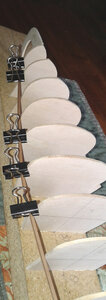- Joined
- Feb 18, 2019
- Messages
- 717
- Points
- 353

 |
As a way to introduce our brass coins to the community, we will raffle off a free coin during the month of August. Follow link ABOVE for instructions for entering. |
 |





Doesn't this first strip get covered by outside whale at midship where you are talking about pinning it to molds?


Looks nice. Have you seen full scale canoes designed like this?
Just wondering how many there may be like it.
Kurt
